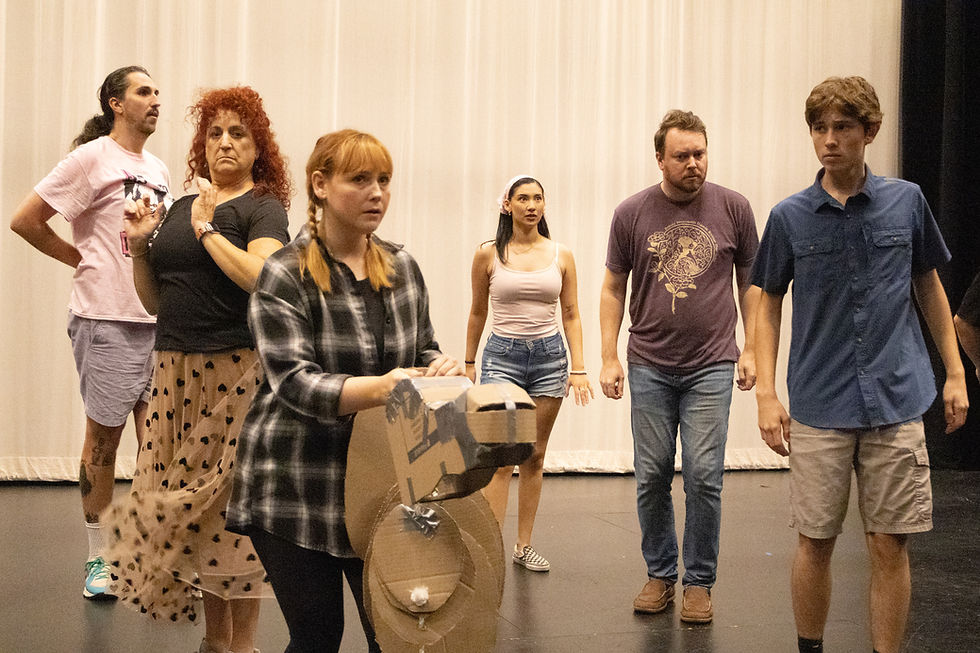Exploring the Role of Intimacy Coordinators: Insights from the OCTG Membership Meeting Panel Discussion
- Claire Pearson
- Apr 8
- 3 min read
By Kathy Harris
On February 22nd, the OCTG Membership Meeting hosted a panel discussion on the evolving role of intimacy coordinators. As the industry continues to prioritize safe and respectful working environments, this conversation shed light on the essential responsibilities, challenges, and best practices surrounding intimacy choreography.

Shinshin Tsai – is a Resident Artist and Producing Associate at Chance Theater. As an intimacy director, his credits include productions at Chance Theater, East West Players, UC Riverside. He is a Board Member-Council for OCTG.
Amanda Hallman has trained with both Theatrical Intimacy Education and Intimacy Directors and Coordinators and is the co-founder and co-producer of ‘Begins and Ends with A Productions’. She is a newly elected OCTG Board Member.
Sarah Ripper is trained in Theatrical Intimacy and Boundary Practices and has choreographed intimacy for various colleges and universities in Orange County. She recently served as the resident intimacy choreographer for The Wayward Artist in Santa Ana.
An intimacy coordinator is responsible for ensuring that actors feel safe, respected, and empowered during scenes involving intimate content. They facilitate clear communication between performers and directors, establish boundaries, and help create choreography that aligns with the story while maintaining consent and professionalism. Their presence has become increasingly vital in fostering a culture of trust and accountability on set and stage. According to Shinshin Tsai, "My role isn’t to hinder creativity but to enhance it by ensuring that everyone involved is comfortable and confident in telling the story authentically."
The panelists, comprising experienced intimacy coordinators and industry professionals, delved into various aspects of the role, highlighting the significance of:
Consent and Communication Open dialogue between actors and production teams is crucial to setting clear boundaries and expectations. Intimacy coordinators help navigate these conversations to ensure everyone involved feels heard and respected. Panelist Amanda Hallman referred to the five C’s: Communication, Consent, Context, Choreography and Closure.
Choreographing Intimacy Just like fight choreography, intimate scenes require careful planning and coordination to maintain both artistic integrity and actor comfort. Panelists emphasized the importance of structured approaches to staging these moments with precision and care. Hallman emphasized, “Is the intimacy choreography clear and is it repeatable…in theatre especially, it’s so important. Can we do this multiple times and have the same effect and tell that story?”
Advocacy and Safety: The presence of an intimacy coordinator provides actors with an advocate who prioritizes their well-being. This role helps prevent miscommunication, or discomfort, particularly in high-pressure environments. Tsai emphasized, "We act as a bridge between performers and directors, ensuring that artistic vision and actor safety go hand in hand."
Industry Standards and Training As the field of intimacy coordination grows, so does the need for standardized training and certification programs. The panel discussed best practices to ensure consistency across productions. Sarah Ripper remarked, "Standardized training is essential because it ensures that every intimacy coordinator upholds the same high standards of safety and professionalism."
The OCTG Membership Meeting’s panel discussion highlighted the impact of intimacy coordination, educating both established and emerging industry professionals to support and implement best practices. Audience members were able to ask questions which included working with family dynamics which included hugging and familiar touch. As this field continues to develop, fostering education and awareness will be key to ensuring that intimacy coordination becomes an important part of storytelling in theatre. The conversation has only just begun, and with continued collaboration and advocacy, the industry can create safer, more inclusive spaces for all performers. The panel was moderated by Kathy Harris, OCTG Board Member-Elect.




Comments